ACCM4300: Financial and Accounting Reporting Issues in Consolidation
VerifiedAdded on 2022/08/26
|6
|1233
|23
Report
AI Summary
This report addresses financial and accounting reporting issues faced by Tom Ltd, focusing on consolidated financial statements. The report, written in the form of a letter from a graduate accountant to the CEO, analyzes issues related to intragroup transactions and accounting for investments in subsidiaries. It emphasizes the importance of eliminating intragroup transactions to avoid double posting and misrepresentation of financial position, referencing AASB 127. The report also discusses accounting for investments based on AASB 127, highlighting the need for proper disclosures regarding investment percentages and minority interests. Recommendations are provided to ensure accurate financial reporting and compliance with accounting standards, offering solutions and explanations to the client's queries. The report concludes with a reference list of sources used.
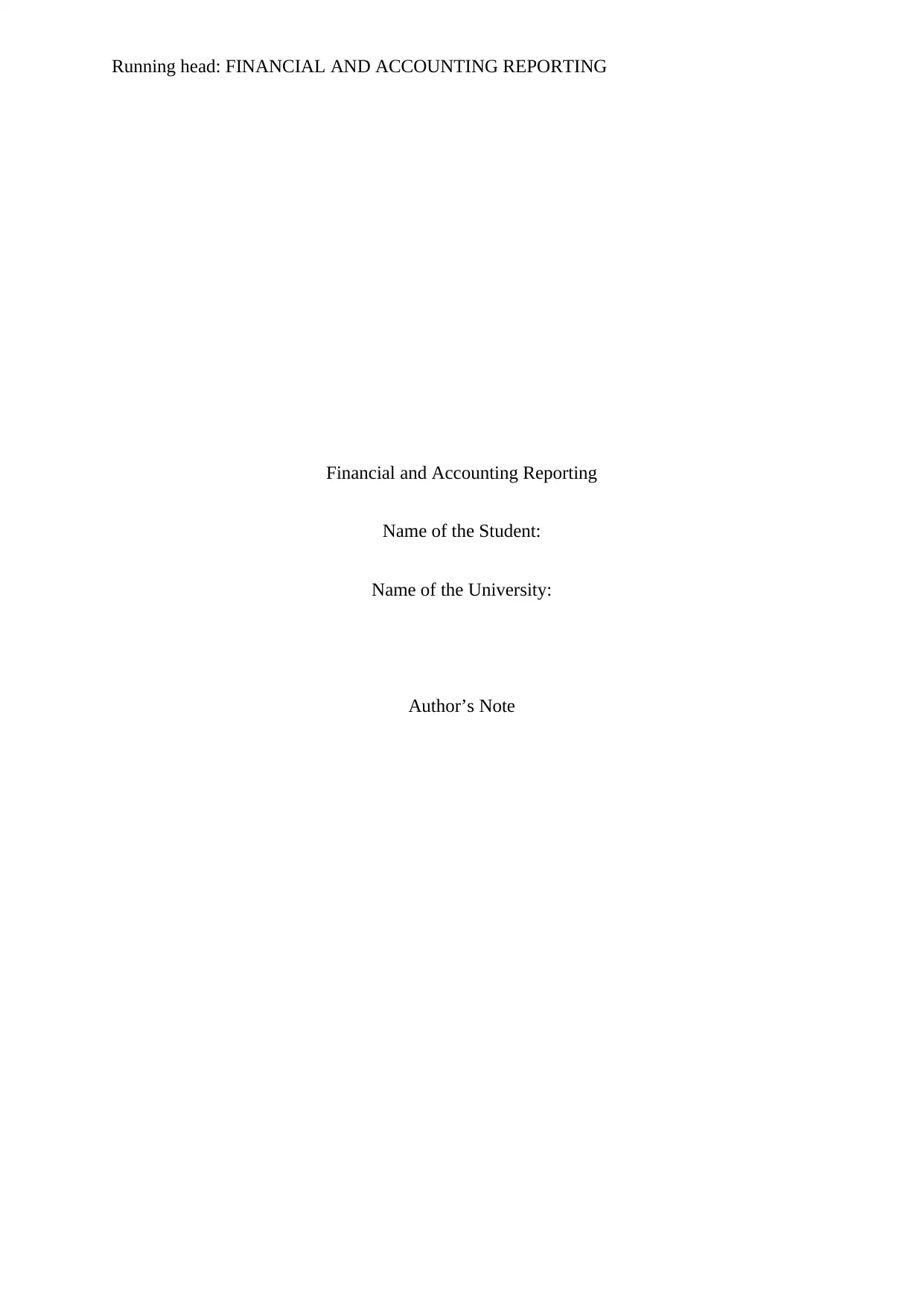
Running head: FINANCIAL AND ACCOUNTING REPORTING
Financial and Accounting Reporting
Name of the Student:
Name of the University:
Author’s Note
Financial and Accounting Reporting
Name of the Student:
Name of the University:
Author’s Note
Paraphrase This Document
Need a fresh take? Get an instant paraphrase of this document with our AI Paraphraser
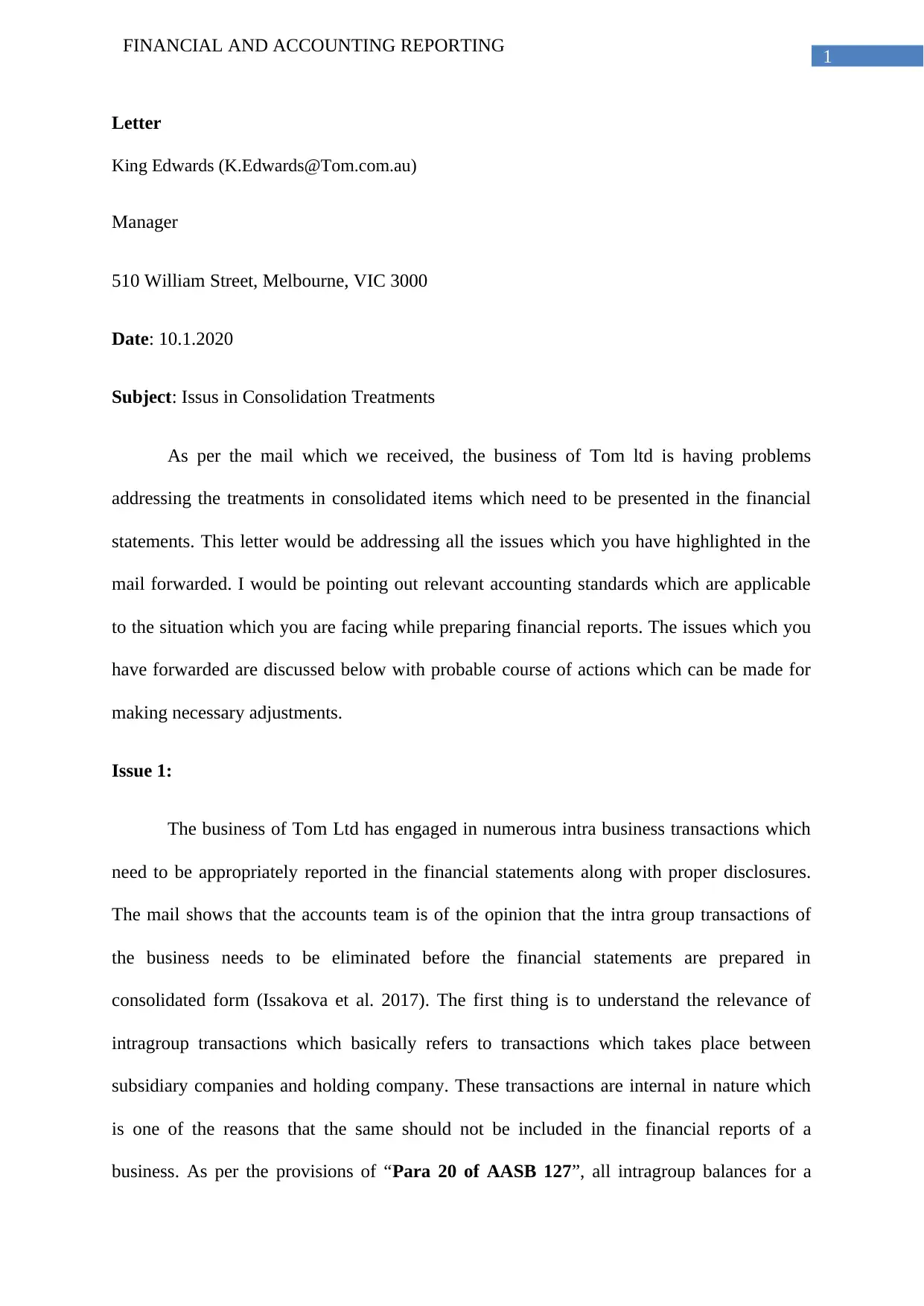
1
FINANCIAL AND ACCOUNTING REPORTING
Letter
King Edwards (K.Edwards@Tom.com.au)
Manager
510 William Street, Melbourne, VIC 3000
Date: 10.1.2020
Subject: Issus in Consolidation Treatments
As per the mail which we received, the business of Tom ltd is having problems
addressing the treatments in consolidated items which need to be presented in the financial
statements. This letter would be addressing all the issues which you have highlighted in the
mail forwarded. I would be pointing out relevant accounting standards which are applicable
to the situation which you are facing while preparing financial reports. The issues which you
have forwarded are discussed below with probable course of actions which can be made for
making necessary adjustments.
Issue 1:
The business of Tom Ltd has engaged in numerous intra business transactions which
need to be appropriately reported in the financial statements along with proper disclosures.
The mail shows that the accounts team is of the opinion that the intra group transactions of
the business needs to be eliminated before the financial statements are prepared in
consolidated form (Issakova et al. 2017). The first thing is to understand the relevance of
intragroup transactions which basically refers to transactions which takes place between
subsidiary companies and holding company. These transactions are internal in nature which
is one of the reasons that the same should not be included in the financial reports of a
business. As per the provisions of “Para 20 of AASB 127”, all intragroup balances for a
FINANCIAL AND ACCOUNTING REPORTING
Letter
King Edwards (K.Edwards@Tom.com.au)
Manager
510 William Street, Melbourne, VIC 3000
Date: 10.1.2020
Subject: Issus in Consolidation Treatments
As per the mail which we received, the business of Tom ltd is having problems
addressing the treatments in consolidated items which need to be presented in the financial
statements. This letter would be addressing all the issues which you have highlighted in the
mail forwarded. I would be pointing out relevant accounting standards which are applicable
to the situation which you are facing while preparing financial reports. The issues which you
have forwarded are discussed below with probable course of actions which can be made for
making necessary adjustments.
Issue 1:
The business of Tom Ltd has engaged in numerous intra business transactions which
need to be appropriately reported in the financial statements along with proper disclosures.
The mail shows that the accounts team is of the opinion that the intra group transactions of
the business needs to be eliminated before the financial statements are prepared in
consolidated form (Issakova et al. 2017). The first thing is to understand the relevance of
intragroup transactions which basically refers to transactions which takes place between
subsidiary companies and holding company. These transactions are internal in nature which
is one of the reasons that the same should not be included in the financial reports of a
business. As per the provisions of “Para 20 of AASB 127”, all intragroup balances for a
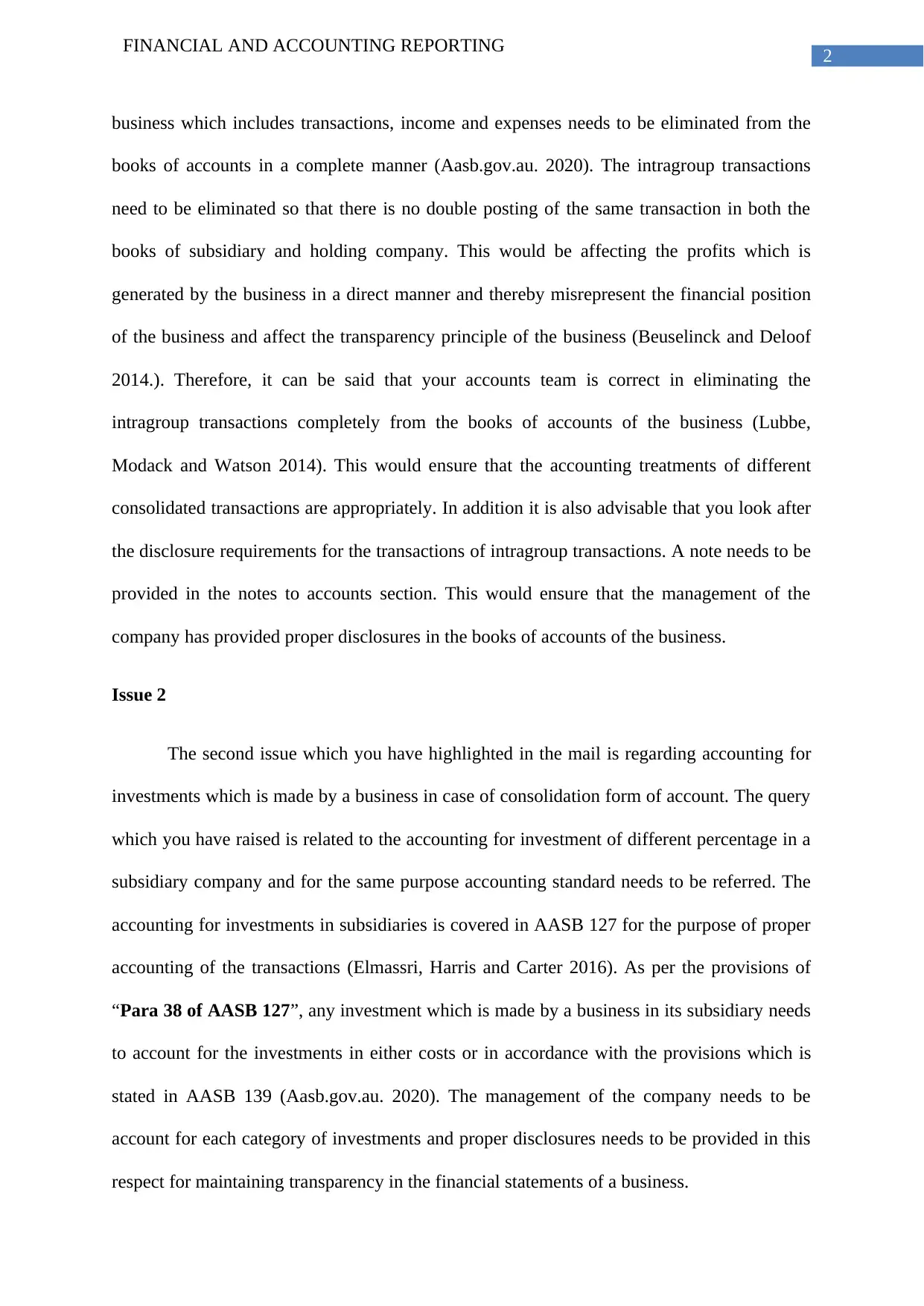
2
FINANCIAL AND ACCOUNTING REPORTING
business which includes transactions, income and expenses needs to be eliminated from the
books of accounts in a complete manner (Aasb.gov.au. 2020). The intragroup transactions
need to be eliminated so that there is no double posting of the same transaction in both the
books of subsidiary and holding company. This would be affecting the profits which is
generated by the business in a direct manner and thereby misrepresent the financial position
of the business and affect the transparency principle of the business (Beuselinck and Deloof
2014.). Therefore, it can be said that your accounts team is correct in eliminating the
intragroup transactions completely from the books of accounts of the business (Lubbe,
Modack and Watson 2014). This would ensure that the accounting treatments of different
consolidated transactions are appropriately. In addition it is also advisable that you look after
the disclosure requirements for the transactions of intragroup transactions. A note needs to be
provided in the notes to accounts section. This would ensure that the management of the
company has provided proper disclosures in the books of accounts of the business.
Issue 2
The second issue which you have highlighted in the mail is regarding accounting for
investments which is made by a business in case of consolidation form of account. The query
which you have raised is related to the accounting for investment of different percentage in a
subsidiary company and for the same purpose accounting standard needs to be referred. The
accounting for investments in subsidiaries is covered in AASB 127 for the purpose of proper
accounting of the transactions (Elmassri, Harris and Carter 2016). As per the provisions of
“Para 38 of AASB 127”, any investment which is made by a business in its subsidiary needs
to account for the investments in either costs or in accordance with the provisions which is
stated in AASB 139 (Aasb.gov.au. 2020). The management of the company needs to be
account for each category of investments and proper disclosures needs to be provided in this
respect for maintaining transparency in the financial statements of a business.
FINANCIAL AND ACCOUNTING REPORTING
business which includes transactions, income and expenses needs to be eliminated from the
books of accounts in a complete manner (Aasb.gov.au. 2020). The intragroup transactions
need to be eliminated so that there is no double posting of the same transaction in both the
books of subsidiary and holding company. This would be affecting the profits which is
generated by the business in a direct manner and thereby misrepresent the financial position
of the business and affect the transparency principle of the business (Beuselinck and Deloof
2014.). Therefore, it can be said that your accounts team is correct in eliminating the
intragroup transactions completely from the books of accounts of the business (Lubbe,
Modack and Watson 2014). This would ensure that the accounting treatments of different
consolidated transactions are appropriately. In addition it is also advisable that you look after
the disclosure requirements for the transactions of intragroup transactions. A note needs to be
provided in the notes to accounts section. This would ensure that the management of the
company has provided proper disclosures in the books of accounts of the business.
Issue 2
The second issue which you have highlighted in the mail is regarding accounting for
investments which is made by a business in case of consolidation form of account. The query
which you have raised is related to the accounting for investment of different percentage in a
subsidiary company and for the same purpose accounting standard needs to be referred. The
accounting for investments in subsidiaries is covered in AASB 127 for the purpose of proper
accounting of the transactions (Elmassri, Harris and Carter 2016). As per the provisions of
“Para 38 of AASB 127”, any investment which is made by a business in its subsidiary needs
to account for the investments in either costs or in accordance with the provisions which is
stated in AASB 139 (Aasb.gov.au. 2020). The management of the company needs to be
account for each category of investments and proper disclosures needs to be provided in this
respect for maintaining transparency in the financial statements of a business.
⊘ This is a preview!⊘
Do you want full access?
Subscribe today to unlock all pages.

Trusted by 1+ million students worldwide
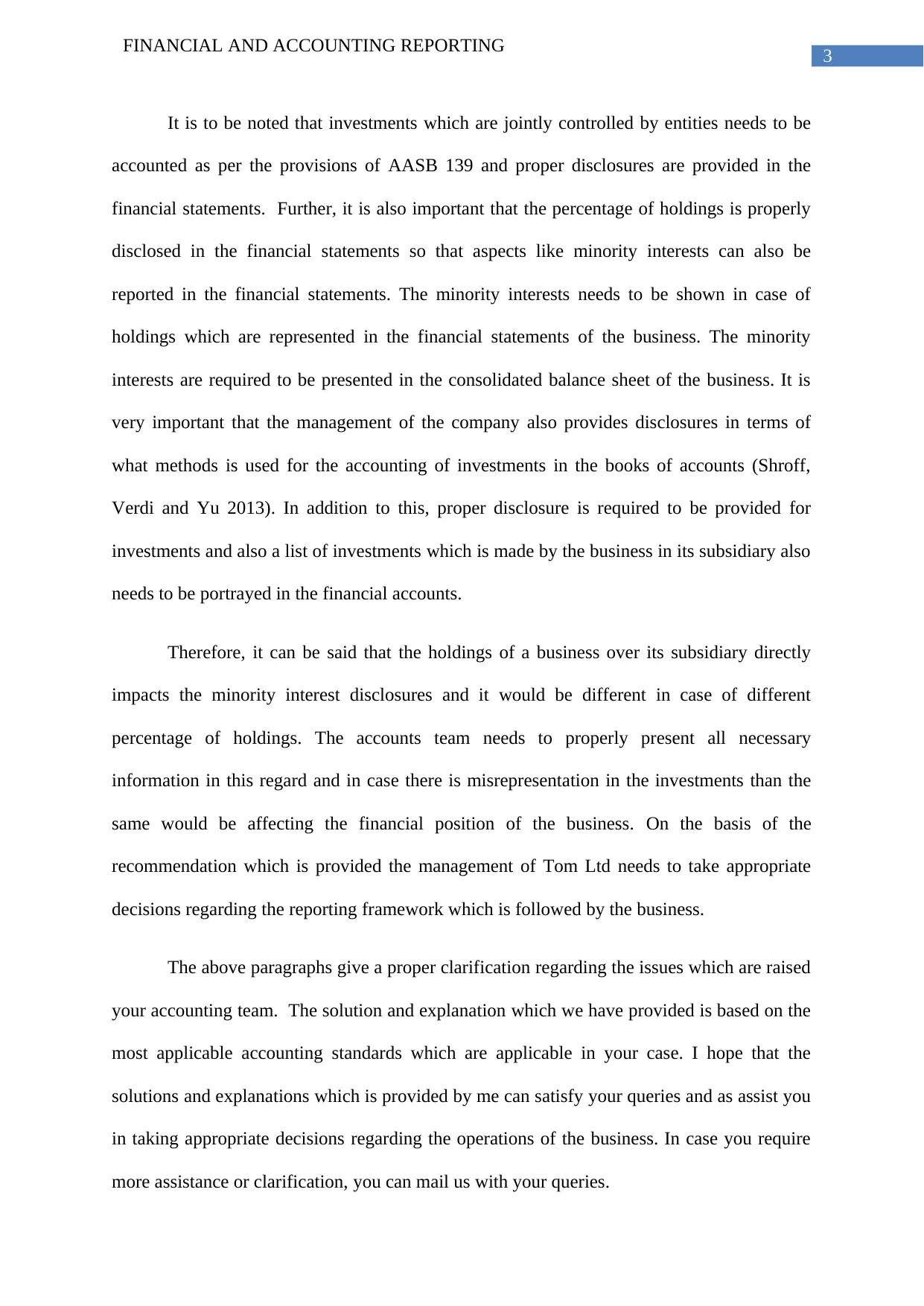
3
FINANCIAL AND ACCOUNTING REPORTING
It is to be noted that investments which are jointly controlled by entities needs to be
accounted as per the provisions of AASB 139 and proper disclosures are provided in the
financial statements. Further, it is also important that the percentage of holdings is properly
disclosed in the financial statements so that aspects like minority interests can also be
reported in the financial statements. The minority interests needs to be shown in case of
holdings which are represented in the financial statements of the business. The minority
interests are required to be presented in the consolidated balance sheet of the business. It is
very important that the management of the company also provides disclosures in terms of
what methods is used for the accounting of investments in the books of accounts (Shroff,
Verdi and Yu 2013). In addition to this, proper disclosure is required to be provided for
investments and also a list of investments which is made by the business in its subsidiary also
needs to be portrayed in the financial accounts.
Therefore, it can be said that the holdings of a business over its subsidiary directly
impacts the minority interest disclosures and it would be different in case of different
percentage of holdings. The accounts team needs to properly present all necessary
information in this regard and in case there is misrepresentation in the investments than the
same would be affecting the financial position of the business. On the basis of the
recommendation which is provided the management of Tom Ltd needs to take appropriate
decisions regarding the reporting framework which is followed by the business.
The above paragraphs give a proper clarification regarding the issues which are raised
your accounting team. The solution and explanation which we have provided is based on the
most applicable accounting standards which are applicable in your case. I hope that the
solutions and explanations which is provided by me can satisfy your queries and as assist you
in taking appropriate decisions regarding the operations of the business. In case you require
more assistance or clarification, you can mail us with your queries.
FINANCIAL AND ACCOUNTING REPORTING
It is to be noted that investments which are jointly controlled by entities needs to be
accounted as per the provisions of AASB 139 and proper disclosures are provided in the
financial statements. Further, it is also important that the percentage of holdings is properly
disclosed in the financial statements so that aspects like minority interests can also be
reported in the financial statements. The minority interests needs to be shown in case of
holdings which are represented in the financial statements of the business. The minority
interests are required to be presented in the consolidated balance sheet of the business. It is
very important that the management of the company also provides disclosures in terms of
what methods is used for the accounting of investments in the books of accounts (Shroff,
Verdi and Yu 2013). In addition to this, proper disclosure is required to be provided for
investments and also a list of investments which is made by the business in its subsidiary also
needs to be portrayed in the financial accounts.
Therefore, it can be said that the holdings of a business over its subsidiary directly
impacts the minority interest disclosures and it would be different in case of different
percentage of holdings. The accounts team needs to properly present all necessary
information in this regard and in case there is misrepresentation in the investments than the
same would be affecting the financial position of the business. On the basis of the
recommendation which is provided the management of Tom Ltd needs to take appropriate
decisions regarding the reporting framework which is followed by the business.
The above paragraphs give a proper clarification regarding the issues which are raised
your accounting team. The solution and explanation which we have provided is based on the
most applicable accounting standards which are applicable in your case. I hope that the
solutions and explanations which is provided by me can satisfy your queries and as assist you
in taking appropriate decisions regarding the operations of the business. In case you require
more assistance or clarification, you can mail us with your queries.
Paraphrase This Document
Need a fresh take? Get an instant paraphrase of this document with our AI Paraphraser

4
FINANCIAL AND ACCOUNTING REPORTING
Regards
Samantha Cole
FINANCIAL AND ACCOUNTING REPORTING
Regards
Samantha Cole
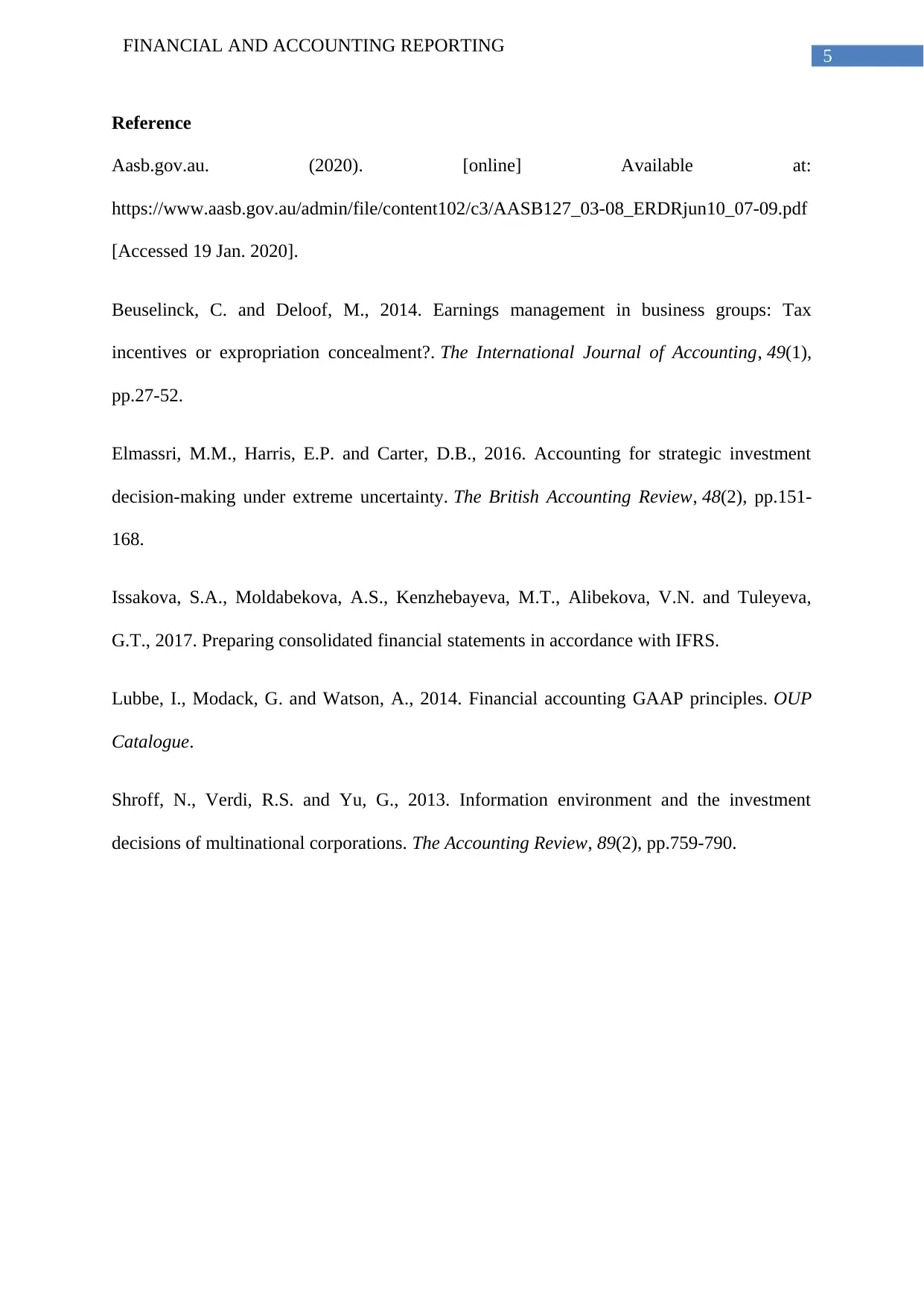
5
FINANCIAL AND ACCOUNTING REPORTING
Reference
Aasb.gov.au. (2020). [online] Available at:
https://www.aasb.gov.au/admin/file/content102/c3/AASB127_03-08_ERDRjun10_07-09.pdf
[Accessed 19 Jan. 2020].
Beuselinck, C. and Deloof, M., 2014. Earnings management in business groups: Tax
incentives or expropriation concealment?. The International Journal of Accounting, 49(1),
pp.27-52.
Elmassri, M.M., Harris, E.P. and Carter, D.B., 2016. Accounting for strategic investment
decision-making under extreme uncertainty. The British Accounting Review, 48(2), pp.151-
168.
Issakova, S.A., Moldabekova, A.S., Kenzhebayeva, M.T., Аlibekova, V.N. and Tuleyeva,
G.T., 2017. Preparing consolidated financial statements in accordance with IFRS.
Lubbe, I., Modack, G. and Watson, A., 2014. Financial accounting GAAP principles. OUP
Catalogue.
Shroff, N., Verdi, R.S. and Yu, G., 2013. Information environment and the investment
decisions of multinational corporations. The Accounting Review, 89(2), pp.759-790.
FINANCIAL AND ACCOUNTING REPORTING
Reference
Aasb.gov.au. (2020). [online] Available at:
https://www.aasb.gov.au/admin/file/content102/c3/AASB127_03-08_ERDRjun10_07-09.pdf
[Accessed 19 Jan. 2020].
Beuselinck, C. and Deloof, M., 2014. Earnings management in business groups: Tax
incentives or expropriation concealment?. The International Journal of Accounting, 49(1),
pp.27-52.
Elmassri, M.M., Harris, E.P. and Carter, D.B., 2016. Accounting for strategic investment
decision-making under extreme uncertainty. The British Accounting Review, 48(2), pp.151-
168.
Issakova, S.A., Moldabekova, A.S., Kenzhebayeva, M.T., Аlibekova, V.N. and Tuleyeva,
G.T., 2017. Preparing consolidated financial statements in accordance with IFRS.
Lubbe, I., Modack, G. and Watson, A., 2014. Financial accounting GAAP principles. OUP
Catalogue.
Shroff, N., Verdi, R.S. and Yu, G., 2013. Information environment and the investment
decisions of multinational corporations. The Accounting Review, 89(2), pp.759-790.
⊘ This is a preview!⊘
Do you want full access?
Subscribe today to unlock all pages.

Trusted by 1+ million students worldwide
1 out of 6
Related Documents
Your All-in-One AI-Powered Toolkit for Academic Success.
+13062052269
info@desklib.com
Available 24*7 on WhatsApp / Email
![[object Object]](/_next/static/media/star-bottom.7253800d.svg)
Unlock your academic potential
Copyright © 2020–2025 A2Z Services. All Rights Reserved. Developed and managed by ZUCOL.





